

Project-Based Learning Research Review. Editor's Note: This article was originally written by Vanessa Vega, with subsequent updates made by the Edutopia staff.
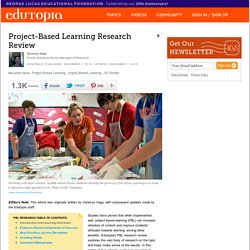
Studies have proven that when implemented well, project-based learning (PBL) can increase retention of content and improve students' attitudes towards learning, among other benefits. Edutopia's PBL research review explores the vast body of research on the topic and helps make sense of the results. In this series of five articles, learn how researchers define project-based learning, review some of the possible learning outcomes, get our recommendations of evidence-based components for successful PBL, learn about best practices across disciplines, find tips for avoiding pitfalls when implementing PBL programs, and dig in to a comprehensive annotated bibliography with links to all the studies and reports cited in these pages.
Problem Solving. Home | A-Z List | Standards | Topics Problem Solving Resources: Links to Problem Solving Sites Links to Problem Solving Sites: Grades K-8 Links to Problem Solving Sites Links to Logical Thinking/Brain Teaser Sites Back to Problem Solving Menu.
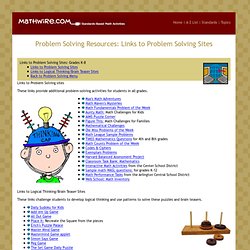
Training Teachers to Teach Critical Thinking. How KIPP educators instruct their colleagues to enhance their classroom practice.

KIPP King Collegiate High School principal Jason Singer trains his teachers to lead Socratic discussions (above); Katie Kirkpatrick (right), dean of instruction, developed a step-by-step framework -- described below -- for teaching students basic critical-thinking skills. Credit: Zachary Fink Thinking critically is one thing, but being able to teach it can be quite another. Katie Kirkpatrick, dean of instruction at KIPP King Collegiate High School, developed the school's Speech & Composition class, a requirement for all students. In the class, students learn basic critical-thinking skills. Define what critical thinking in the classroom is. Robert Kaplinsky - Glenrock Consulting. Skip to content Search Search: Lessons View allKinder1st2nd3rd4th5th6th7th8thAlg 1GeoAlg 2.
Math - Byrdseed. Habits of Mind. Over the past few weeks I've been thinking about the Habits of Mind as described by Art Costa and Bena Kallick.

These habits of mind are the dispositions that a student has towards behaving intelligently when confronted with problems. My question has been, do the PYP Attitudes and the IB Learner Profile also promote these habits of mind? How to Trigger Students’ Inquiry Through Projects. Inquiry Learning Teaching Strategies Krauss/Boss By Jane Krauss and Suzie Boss Excerpt from Thinking Through Project-Based Learning: Guiding Deeper Inquiry, published by Corwin, 2013.

When students engage in quality projects, they develop knowledge, skills, and dispositions that serve them in the moment and in the long term. Unfortunately, not all projects live up to their potential. Why 20% Time is Good for Schools. Have you ever met an adult who doesn't really love what they do, but just goes through the motions in their job and everyday life?

Have you spoken with men and women who constantly complain, showing no visible passion for anything in the world? I'm sure that, like me, you have met those people. I've also seen the making of these adults in schools across our country: students who are consistently being "prepared" for the next test, assessment, or grade level . . . only to find out after graduation that they don't really know what they are passionate about. Building Parent Support for Project-Based Learning. Todd Nesloney. SAMR Model Apps Poster.
The 8 Elements Project-Based Learning Must Have. How To Use Google Drive and Evernote To Create Digital Portfolios. The following post is written by Greg Kulowiec & Beth Holland from EdTechTeacher.
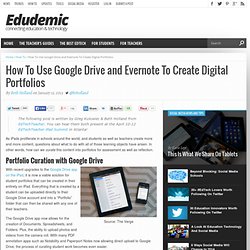
You can hear them both present at the April 10-12 EdTechTeacher iPad Summit in Atlanta! QR Code Classroom Implementation Guide. QR Codes (Quick Response Codes) are just barcodes.
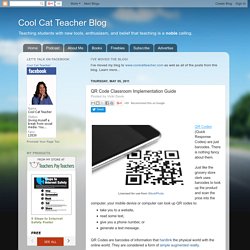
There is nothing fancy about them. Just like the grocery store clerk uses barcodes to look up the product and scan the price into the computer, your mobile device or computer can look up QR codes to: take you to a website, read some text, give you a phone number, or generate a text message. QR Codes are barcodes of information that hardlink the physical world with the online world. They are considered a form of simple augmented reality. QR Codes in the Classroom For the classroom teacher, they are valuable for three reasons: They can save us time.They can save paper.They provide a link to mobile devices that help students do their homework and follow along. 7 Tech Tools for Collaboration. Remember when collaborating with your colleagues was limited to early morning meetings or an epically long professional day?

Now technology has given us the power to connect on our own time, in dynamic new ways and with teacher friends from around the world. Here are some of our favorite tools for learning from one another, sharing best practices and growing as an educator along the way. 1. Twitter: If Facebook is for connecting with the friends you have in real life, Twitter is for connecting with the friends you wish you had. Swap ideas with education experts, brands, edubloggers and more. 2. 3. 4. Using Gallery Walks for Revision and Reflection. By Charity Allen and John Larmer One of the Eight Essential Elements of Project Based Learning is Revision and Reflection.
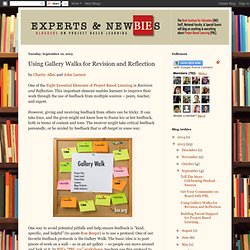
This important element enables learners to improve their work through the use of feedback from multiple sources – peers, teacher, and expert. However, giving and receiving feedback from others can be tricky.